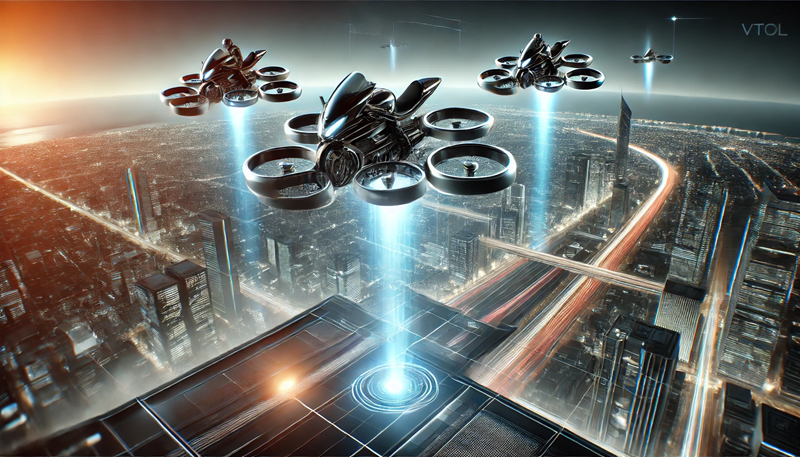The concept of flying motorcycles may sound like something out of a sci-fi movie, but this innovative mode of transportation is closer to becoming a reality than many might think. With companies like Jetpack Aviation, HoverSurf, and Speeder leading the charge, flying motorcycles are poised to revolutionize the way we travel, especially in urban environments. But is the flying motorcycle truly the next big thing in transportation, or is it just another futuristic gimmick? Let’s explore.
What Are Flying Motorcycles?
Flying motorcycles, also known as hover bikes or aerial motorcycles, are vehicles designed to combine the agility of motorcycles with the vertical mobility of aircraft. These machines use advanced propulsion systems, such as electric rotors, jet turbines, or hybrid engines, to take off, hover, and navigate the skies.
How They Work:
- Vertical Take-Off and Landing (VTOL): Many flying motorcycles are equipped with VTOL capabilities, allowing them to take off and land without a runway.
- Electric or Hybrid Power: Most models prioritize sustainability, using electric or hybrid engines to reduce emissions.
- Lightweight Design: Built with lightweight materials like carbon fiber, these vehicles maximize efficiency and speed.
Advantages of Flying Motorcycles
1. Solving Urban Traffic Problems
One of the biggest promises of flying motorcycles is their potential to alleviate traffic congestion. In cities where gridlocked streets are a daily headache, these vehicles can provide a faster, more direct route to destinations.
2. Faster Commutes
Flying motorcycles can reach speeds of over 150 mph, cutting commute times dramatically, especially in densely populated urban areas.
3. Reduced Carbon Footprint
Many flying motorcycles are designed with electric or hybrid propulsion systems, making them an eco-friendly alternative to traditional vehicles.
4. Emergency Applications
Beyond personal use, flying motorcycles could revolutionize emergency services, enabling faster response times for medical emergencies or disaster relief.
Challenges Facing Flying Motorcycles
1. Safety Concerns
Safety remains a significant challenge. Piloting a flying motorcycle requires advanced training, and ensuring the safety of riders, passengers, and people below is paramount.
2. Regulatory Hurdles
Governments worldwide are grappling with how to regulate airspace for flying motorcycles. Questions about licensing, air traffic control, and usage zones remain unresolved.
3. High Costs
With price tags reaching hundreds of thousands of dollars, flying motorcycles are currently out of reach for most consumers.
4. Infrastructure Requirements
Adopting flying motorcycles at scale would require significant investment in infrastructure, such as charging stations, designated landing zones, and air traffic management systems.
Flying Motorcycle Innovations in 2025
Top Companies Leading the Charge
1. Jetpack Aviation: The Speeder
Jetpack Aviation’s Speeder has set a new benchmark in flying motorcycle innovation. Designed for both civilian and military applications, the Speeder is powered by jet turbine engines, enabling vertical take-off and landing (VTOL) capabilities.
Key Features:
- Speed: Promises top speeds of up to 240 mph, making it one of the fastest flying motorcycles in development.
- Payload Capacity: Can carry up to 600 pounds, suitable for transporting goods or emergency equipment.
- Use Cases: Military operations, medical evacuations, and firefighting missions.
- Technology: Equipped with a fly-by-wire control system, ensuring precise and stable maneuverability.
- Price Point: Estimated to cost between $380,000 and $500,000, positioning it as a luxury or specialized tool.
2. HoverSurf: The HoverBike S3
HoverSurf’s HoverBike S3 has gained attention for its futuristic design and practical applications. This lightweight, single-passenger aerial vehicle is powered by quad electric rotors, making it ideal for urban environments.
Key Features:
- Speed: Reaches a maximum speed of 60 mph, focusing on short-distance, low-altitude travel.
- Range: Offers a flight time of 40 minutes on a single charge, with advancements in battery technology underway.
- Safety Features: Includes automatic altitude control and an emergency landing system.
- Target Market: Personal use, professional services like security patrols, and pilot training programs.
- Cost: Priced around $150,000, making it one of the more accessible flying motorcycles on the market.
3. Lazareth: The LMV 496 Hybrid
Lazareth’s LMV 496 stands out with its hybrid design that seamlessly transitions between road and air. This French innovation combines traditional motorcycle functionality with futuristic flying capabilities.
Key Features:
- Dual Modes: Operates as a traditional motorcycle on roads and switches to flying mode with four jet turbines.
- Speed: Reaches a ground speed of 60 mph and takes off to fly at a top speed of 80 mph.
- Range: Offers a flight time of 10 minutes, designed for short aerial hops over traffic or obstacles.
- Build: Lightweight carbon fiber construction ensures durability and performance.
- Target Market: Luxury buyers, technology enthusiasts, and event showcases.
- Price: Costs approximately $560,000, cementing its status as a high-end luxury product.
The Future of Flying Motorcycles: What Experts Say
Industry leaders believe that flying motorcycles could become a viable transportation solution within the next decade, but only if key challenges are addressed. Experts predict that widespread adoption will initially focus on specific niches like emergency services and luxury travel, eventually expanding to everyday use as costs decrease.
What Needs to Happen:
- Policy Development: Governments must create clear regulations for flying motorcycles.
- Mass Production: Increased production will lower costs and make flying motorcycles more accessible.
- Public Perception: Overcoming skepticism and building trust will be crucial for adoption.
Are Flying Motorcycles Worth the Hype?
While the technology is promising, flying motorcycles face an uphill battle in becoming mainstream. However, their potential to transform transportation is undeniable. Whether they become a common sight in our skies depends on addressing safety, affordability, and infrastructure challenges.
Key Takeaway: Flying motorcycles may not replace traditional transportation anytime soon, but they represent a bold step toward a more innovative and efficient future. For now, they remain a symbol of human ingenuity and our relentless pursuit of progress.
Flying motorcycles might still be in their early stages, but they’re already capturing imaginations and pushing the boundaries of what’s possible in transportation. As technology advances and the world adapts to this futuristic concept, flying motorcycles could well become a reality for many.
